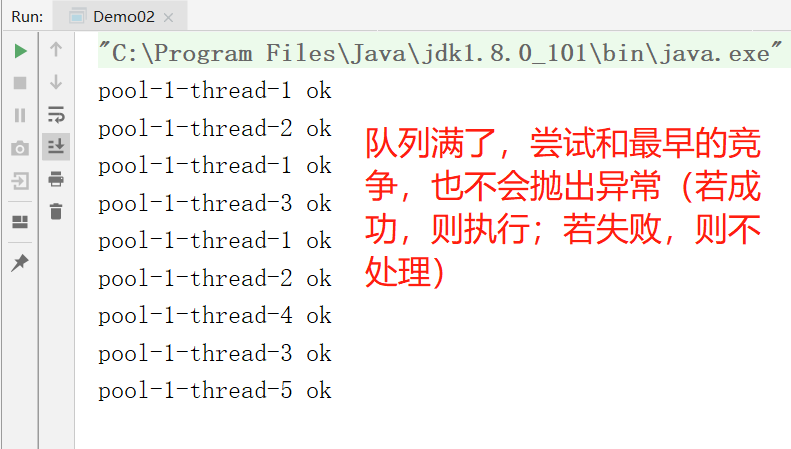Thread pool (focus)
Thread pool: three methods, seven parameters, four rejection strategies
Pooling technology:
01: The operation of the program, essence: occupy system resources!Optimize the use of resources!=>Pooling Technology
02: Thread pool, connection pool, memory pool, object pool //... created, destroyed.Very wasteful of resources
03: Pooling technology: Prepare some resources in advance. If someone wants to use them, come here to pick them up and return them to me when they are finished.
The benefits of thread pooling:
01: Reduce resource consumption
02: Increase response speed
03: Easy to manage
(Key) Thread Reuse, Control Maximum Concurrency, Manage Threads
Two: Three main methods:
01:Executors.newSingleThreadExecutor() //Single Thread
* Code Sample 01
1 package pool; 2 3 import java.util.concurrent.ExecutorService; 4 import java.util.concurrent.Executors; 5 6 //Executors Tool classes, three main methods 7 8 public class Demo01 { 9 public static void main(String[] args) { 10 11 ExecutorService threadpool = Executors.newSingleThreadExecutor(); //Single Thread 12 13 try { 14 for (int i = 0; i < 10; i++) { 15 //After using thread pools, use thread pools to create threads 16 threadpool.execute(()->{ 17 System.out.println(Thread.currentThread().getName()+" ok"); 18 }); 19 } 20 } catch (Exception e) { 21 e.printStackTrace(); 22 } finally { 23 //Thread pool exhausted, program ended, thread pool closed 24 threadpool.shutdown(); //(To ensure shutdown, place the shutdown method in the finally Medium) 25 } 26 } 27 }
Run result: (10 tasks are operated on by the same thread)
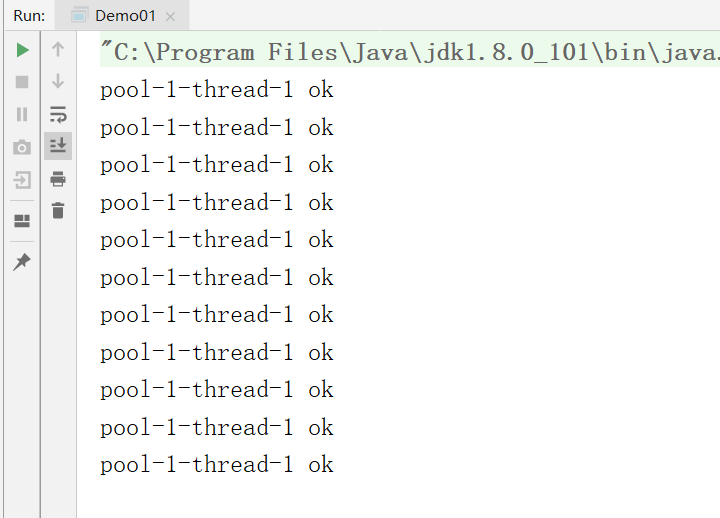
02:newFixedThreadPool(int nThreads) //Create a fixed thread pool size
* Code Sample 02
1 package pool; 2 3 import java.util.concurrent.ExecutorService; 4 import java.util.concurrent.Executors; 5 6 //Executors Tool classes, three main methods 7 8 public class Demo01 { 9 public static void main(String[] args) { 10 11 //Up to five threads execute simultaneously, viewing results from the console 12 ExecutorService threadpool = Executors.newFixedThreadPool(5); //Create a fixed thread pool size, (5 threads) 13 14 try { 15 for (int i = 0; i < 10; i++) { 16 //After using thread pools, use thread pools to create threads 17 threadpool.execute(()->{ 18 System.out.println(Thread.currentThread().getName()+" ok"); 19 }); 20 } 21 } catch (Exception e) { 22 e.printStackTrace(); 23 } finally { 24 //Thread pool exhausted, program ended, thread pool closed 25 threadpool.shutdown(); //(To ensure shutdown, place the shutdown method in the finally Medium) 26 } 27 } 28 }
Run result: (up to 5 threads executing at the same time)
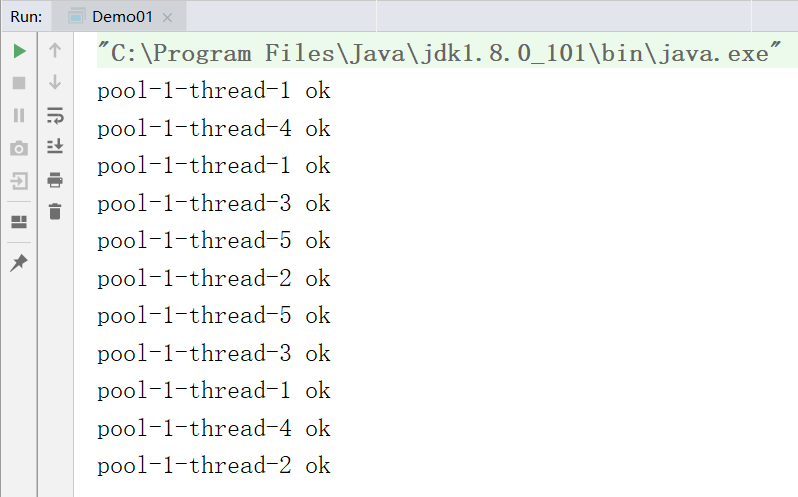
03:newCachedThreadPool //Cache pool, scalable, strong when strong, weak when weak
* Code Sample 03
1 package pool; 2 3 import java.util.concurrent.ExecutorService; 4 import java.util.concurrent.Executors; 5 6 //Executors Tool classes, three main methods 7 8 public class Demo01 { 9 public static void main(String[] args) { 10 11 ExecutorService threadpool = Executors.newCachedThreadPool(); //Cache pool, scalable, strong when strong, weak when weak 12 13 try { 14 for (int i = 0; i < 10; i++) { 15 //After using thread pools, use thread pools to create threads 16 threadpool.execute(()->{ 17 System.out.println(Thread.currentThread().getName()+" ok"); 18 }); 19 } 20 } catch (Exception e) { 21 e.printStackTrace(); 22 } finally { 23 //Thread pool exhausted, program ended, thread pool closed 24 threadpool.shutdown(); //(To ensure shutdown, place the shutdown method in the finally Medium) 25 } 26 } 27 }
Run result: (10 threads executing at the same time, scalable, strong when strong, weak when weak)
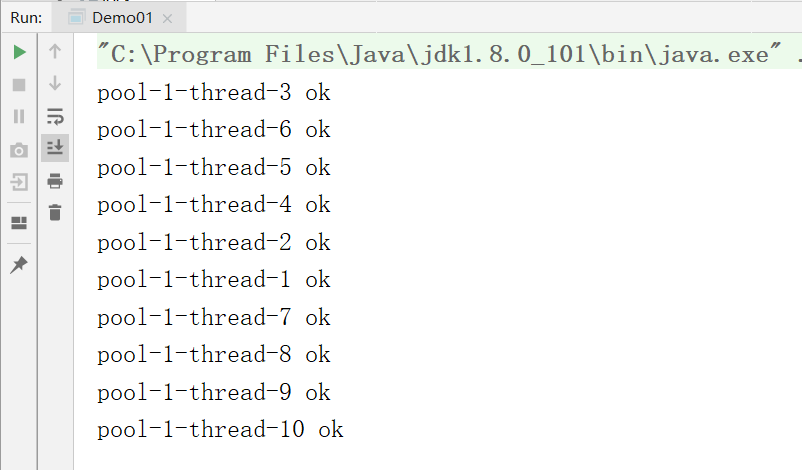
Three: Seven parameters
01: Source analysis of the three main methods:
1 (1) newSingleThreadExecutor() //Single Thread 2 3 public static ExecutorService newSingleThreadExecutor() { 4 return new FinalizableDelegatedExecutorService 5 (new ThreadPoolExecutor(1, 1, 6 0L, TimeUnit.MILLISECONDS, 7 new LinkedBlockingQueue<Runnable>())); 8 } 9 ================================================================================== 10 (2) newFixedThreadPool(int nThreads) //Create a fixed thread pool size 11 12 public static ExecutorService newFixedThreadPool(int nThreads) { 13 return new ThreadPoolExecutor(nThreads, nThreads, 14 0L, TimeUnit.MILLISECONDS, 15 new LinkedBlockingQueue<Runnable>()); 16 } 17 =================================================================================== 18 (3) newCachedThreadPool() //Cache pool, scalable, strong when strong, weak when weak 19 20 public static ExecutorService newCachedThreadPool() { 21 return new ThreadPoolExecutor(0, Integer.MAX_VALUE, //Integer.Max_VALUE About 2.1 billion //If we had so many threads running together, the computer would OOM(overflow),Problem 22 60L, TimeUnit.SECONDS, 23 new SynchronousQueue<Runnable>()); 24 } 25 ==================================================================================== 26 (4) Common to all three methods ThreadPoolExecutor() Method 27 28 ******7 Large parameters****** 29 30 public ThreadPoolExecutor(int corePoolSize, //Core thread pool size 31 int maximumPoolSize, //Maximum Core Thread Pool Size 32 long keepAliveTime, //Timeout will be released if no one calls it 33 TimeUnit unit, //Timeout Unit 34 BlockingQueue<Runnable> workQueue, //Blocking Queue 35 ThreadFactory threadFactory, //Thread factory, which creates threads, normally without action 36 RejectedExecutionHandler handler) { //Rejection Policy 37 if (corePoolSize < 0 || 38 maximumPoolSize <= 0 || 39 maximumPoolSize < corePoolSize || 40 keepAliveTime < 0) 41 throw new IllegalArgumentException(); 42 if (workQueue == null || threadFactory == null || handler == null) 43 throw new NullPointerException(); 44 this.corePoolSize = corePoolSize; 45 this.maximumPoolSize = maximumPoolSize; 46 this.workQueue = workQueue; 47 this.keepAliveTime = unit.toNanos(keepAliveTime); 48 this.threadFactory = threadFactory; 49 this.handler = handler; 50 }
The Alibaba Development Manual contains the following provisions:

For example, bank business map:
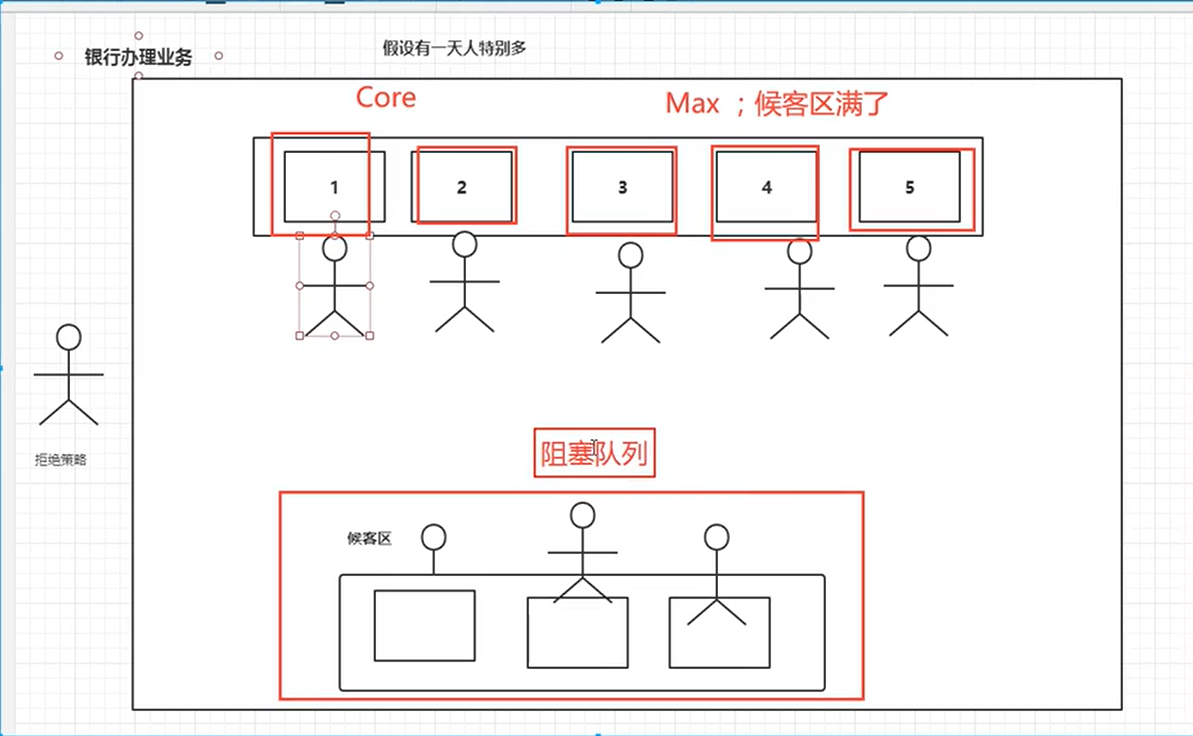
Four rejection strategies:

/**
* NEWThreadPoolExecutor.AbortPolicy() // The bank is full, and someone else comes in and doesn't handle this person, throws an exception
* NEWThreadPoolExecutor.CallerRunsPolicy() / /Where and where to come!
* NEWThreadPoolExecutor.DiscardPolicy() // The queue is full. Throw away the task without throwing an exception!
* NEWThreadPoolExecutor.DiscardOldestPolicy() // The queue is full, try and compete the earliest, and won't throw an exception
*/
5: Create a thread pool manually (custom):
Code Sample 01 > NewThreadPoolExecutor.AbortPolicy() // The bank is full and someone else comes in and throws an exception if they don't handle this person
1 package pool; 2 3 import java.util.concurrent.Executors; 4 import java.util.concurrent.LinkedBlockingDeque; 5 import java.util.concurrent.ThreadPoolExecutor; 6 import java.util.concurrent.TimeUnit; 7 8 public class Demo02 { 9 public static void main(String[] args) { 10 //Custom Thread Pool!Only use in work ThreadPoolExecutor 11 ThreadPoolExecutor threadPool = new ThreadPoolExecutor( 12 2, //Core thread pool size 13 5, //Maximum Core Thread Pool Size 14 3, //Timeout will be released if no one calls it 15 TimeUnit.SECONDS, //Timeout Unit 16 new LinkedBlockingDeque<>(3), //Blocking Queue 17 Executors.defaultThreadFactory(), //Thread factory, which creates threads, normally without action 18 new ThreadPoolExecutor.AbortPolicy()); //The bank is full and there are people coming in who don't handle this person and throw an exception 19 20 try { 21 //Maximum number of bearings, Deque + Max (Number of Queue Threads+Maximum Threads) 22 //Overthrow RejectedExecutionException abnormal 23 for (int i = 1; i <= 9; i++) { 24 //After using thread pools, use thread pools to create threads 25 threadPool.execute(()->{ 26 System.out.println(Thread.currentThread().getName()+" ok"); 27 }); 28 } 29 } catch (Exception e) { 30 e.printStackTrace(); 31 } finally { 32 //Thread pool exhausted, program ended, thread pool closed 33 threadPool.shutdown(); //(To ensure shutdown, place the shutdown method in the finally Medium) 34 } 35 } 36 }
Running results (comparison):

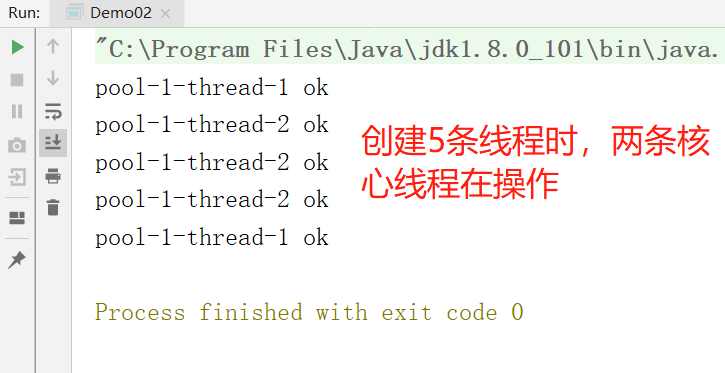
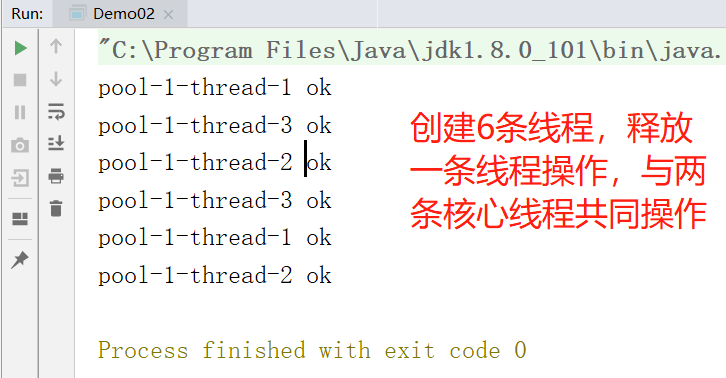
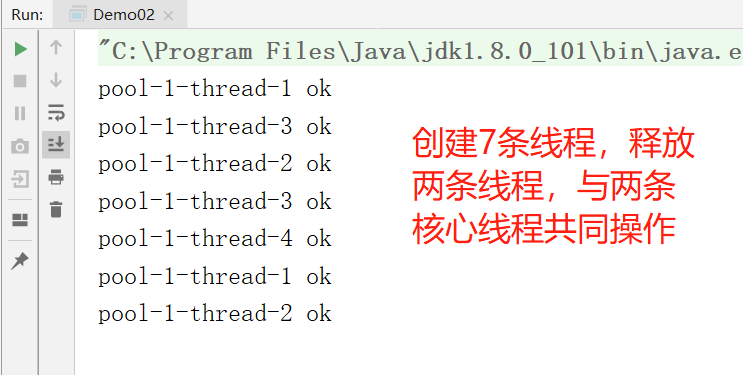
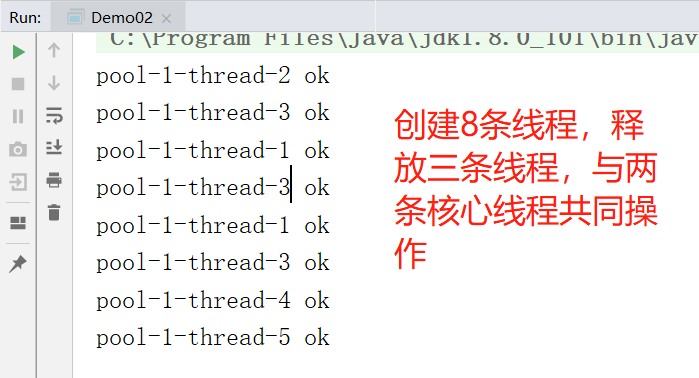
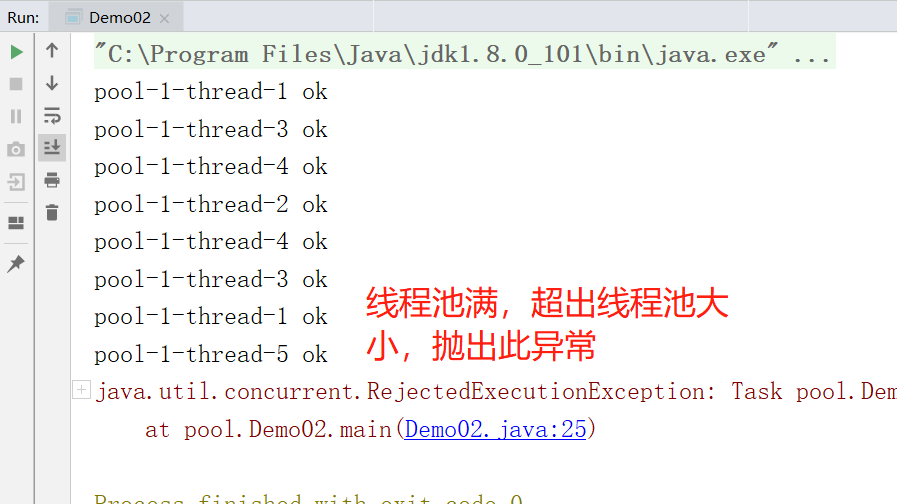
Code Sample 02 NewThreadPoolExecutor.CallerRunsPolicy() Where to/ Where to come
1 package pool; 2 3 import java.util.concurrent.Executors; 4 import java.util.concurrent.LinkedBlockingDeque; 5 import java.util.concurrent.ThreadPoolExecutor; 6 import java.util.concurrent.TimeUnit; 7 8 public class Demo02 { 9 public static void main(String[] args) { 10 //Custom Thread Pool!Only use in work ThreadPoolExecutor 11 ThreadPoolExecutor threadPool = new ThreadPoolExecutor( 12 2, //Core thread pool size 13 5, //Maximum Core Thread Pool Size 14 3, //Timeout will be released if no one calls it 15 TimeUnit.SECONDS, //Timeout Unit 16 new LinkedBlockingDeque<>(3), //Blocking Queue 17 Executors.defaultThreadFactory(), //Thread factory, which creates threads, normally without action 18 new ThreadPoolExecutor.CallerRunsPolicy()); //Where to come and where to go! 19 20 try { 21 //Maximum number of bearings, Deque + Max (Number of Queue Threads+Maximum Threads) 22 //Overthrow RejectedExecutionException abnormal 23 for (int i = 1; i <= 9; i++) { 24 //After using thread pools, use thread pools to create threads 25 threadPool.execute(()->{ 26 System.out.println(Thread.currentThread().getName()+" ok"); 27 }); 28 } 29 } catch (Exception e) { 30 e.printStackTrace(); 31 } finally { 32 //Thread pool exhausted, program ended, thread pool closed 33 threadPool.shutdown(); //(To ensure shutdown, place the shutdown method in the finally Medium) 34 } 35 } 36 }
Run result:
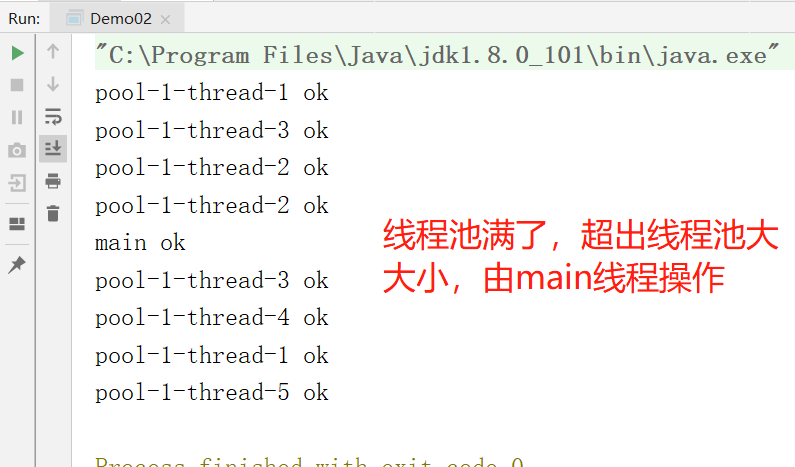
Code Sample 03 NewThreadPoolExecutor.DiscardPolicy() // The queue is full. Throw away the task without throwing an exception!
1 package pool; 2 3 import java.util.concurrent.Executors; 4 import java.util.concurrent.LinkedBlockingDeque; 5 import java.util.concurrent.ThreadPoolExecutor; 6 import java.util.concurrent.TimeUnit; 7 8 public class Demo02 { 9 public static void main(String[] args) { 10 //Custom Thread Pool!Only use in work ThreadPoolExecutor 11 ThreadPoolExecutor threadPool = new ThreadPoolExecutor( 12 2, //Core thread pool size 13 5, //Maximum Core Thread Pool Size 14 3, //Timeout will be released if no one calls it 15 TimeUnit.SECONDS, //Timeout Unit 16 new LinkedBlockingDeque<>(3), //Blocking Queue 17 Executors.defaultThreadFactory(), //Thread factory, which creates threads, normally without action 18 new ThreadPoolExecutor.DiscardPolicy()); //The queue is full, throw the task away, no exceptions will be thrown! 19 20 try { 21 //Maximum number of bearings, Deque + Max (Number of Queue Threads+Maximum Threads) 22 //Overthrow RejectedExecutionException abnormal 23 for (int i = 1; i <= 9; i++) { 24 //After using thread pools, use thread pools to create threads 25 threadPool.execute(()->{ 26 System.out.println(Thread.currentThread().getName()+" ok"); 27 }); 28 } 29 } catch (Exception e) { 30 e.printStackTrace(); 31 } finally { 32 //Thread pool exhausted, program ended, thread pool closed 33 threadPool.shutdown(); //(To ensure shutdown, place the shutdown method in the finally Medium) 34 } 35 } 36 }
Run result:
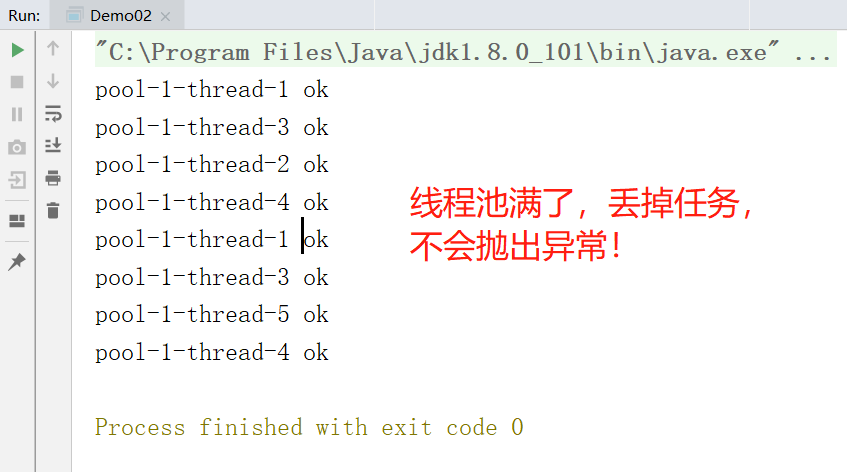
04: Code Sample * NEWThreadPoolExecutor.DiscardOldestPolicy() // The queue is full, try and compete the earliest, and won't throw an exception
1 package pool; 2 3 import java.util.concurrent.Executors; 4 import java.util.concurrent.LinkedBlockingDeque; 5 import java.util.concurrent.ThreadPoolExecutor; 6 import java.util.concurrent.TimeUnit; 7 8 public class Demo02 { 9 public static void main(String[] args) { 10 //Custom Thread Pool!Only use in work ThreadPoolExecutor 11 ThreadPoolExecutor threadPool = new ThreadPoolExecutor( 12 2, //Core thread pool size 13 5, //Maximum Core Thread Pool Size 14 3, //Timeout will be released if no one calls it 15 TimeUnit.SECONDS, //Timeout Unit 16 new LinkedBlockingDeque<>(3), //Blocking Queue 17 Executors.defaultThreadFactory(), //Thread factory, which creates threads, normally without action 18 new ThreadPoolExecutor.DiscardOldestPolicy()); //The queue is full, try and compete the first time, and don't throw an exception 19 20 try { 21 //Maximum number of bearings, Deque + Max (Number of Queue Threads+Maximum Threads) 22 //Overthrow RejectedExecutionException abnormal 23 for (int i = 1; i <= 9; i++) { 24 //After using thread pools, use thread pools to create threads 25 threadPool.execute(()->{ 26 System.out.println(Thread.currentThread().getName()+" ok"); 27 }); 28 } 29 } catch (Exception e) { 30 e.printStackTrace(); 31 } finally { 32 //Thread pool exhausted, program ended, thread pool closed 33 threadPool.shutdown(); //(To ensure shutdown, place the shutdown method in the finally Medium) 34 } 35 } 36 }
Run result:
